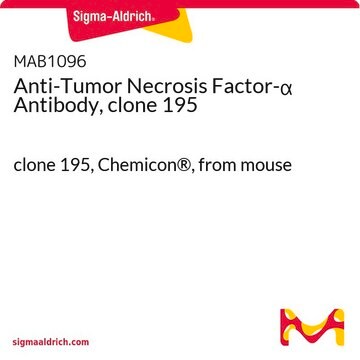MAB1021
Anti-Tumor Necrosis Factor-α Antibody, clone 2C8
clone 2C8, Chemicon®, from mouse
Synonym(s):
TNF-alpha
Sign Into View Organizational & Contract Pricing
All Photos(1)
About This Item
UNSPSC Code:
12352203
eCl@ss:
32160702
NACRES:
NA.41
Recommended Products
biological source
mouse
Quality Level
antibody form
purified antibody
clone
2C8, monoclonal
species reactivity
human
manufacturer/tradename
Chemicon®
technique(s)
ELISA: suitable
immunohistochemistry: suitable
neutralization: suitable
isotype
IgG1
NCBI accession no.
UniProt accession no.
shipped in
wet ice
target post-translational modification
unmodified
Gene Information
human ... TNF(7124)
Specificity
Human tumor necrosis factor-a (TNF-a)
No cross-reactivity observed with rat neuronal tissue.
Immunogen
Human recombinant tumor necrosis factor α.
Application
Detect Tumor Necrosis Factor-α using this Anti-Tumor Necrosis Factor-α Antibody, clone 2C8 validated for use in ELISA, IH, NEUT.
Inhibition Assays – Inhibition of biological activity of recombinant and natural TNF-α.
Detection of TNF-α in two-site immunoassay.
Immunohistochemistry detected TNF-α.
TNF-α Neutralization Assay
1. Plate 2 x 104 murine L929B cells into individual wells of 96-well (flat bottomed) microtiter plate.
2. Incubate overnight at 37°C in humidified 5% CO2 incubator.
3. The next day, prepare serial dilutions of anti-TNF (human) in medium containing 2 μg/mL of actinomycin D, for a final volume of 50 μL
4. Add 50 μL of TNF (10 ng/mL final concentration) to each antibody dilution and incubate for 1 hour at 37°C.
5. Add 100 μL of the antibody/antigen mixture to the pre-seeded L929B cells.
6. Incubate 24 hours at 37°C, 5% CO2.
7. Score wells for cytotoxicity.
Optimal working dilutions must be determined by the end user.
Detection of TNF-α in two-site immunoassay.
Immunohistochemistry detected TNF-α.
TNF-α Neutralization Assay
1. Plate 2 x 104 murine L929B cells into individual wells of 96-well (flat bottomed) microtiter plate.
2. Incubate overnight at 37°C in humidified 5% CO2 incubator.
3. The next day, prepare serial dilutions of anti-TNF (human) in medium containing 2 μg/mL of actinomycin D, for a final volume of 50 μL
4. Add 50 μL of TNF (10 ng/mL final concentration) to each antibody dilution and incubate for 1 hour at 37°C.
5. Add 100 μL of the antibody/antigen mixture to the pre-seeded L929B cells.
6. Incubate 24 hours at 37°C, 5% CO2.
7. Score wells for cytotoxicity.
Optimal working dilutions must be determined by the end user.
Linkage
Replaces: 04-1114
Physical form
Format: Purified
Storage and Stability
Maintain at 2-8°C in undiluted aliquots for up to one year.
Other Notes
Concentration: Please refer to the Certificate of Analysis for the lot-specific concentration.
Legal Information
CHEMICON is a registered trademark of Merck KGaA, Darmstadt, Germany
Storage Class Code
10 - Combustible liquids
WGK
WGK 2
Flash Point(F)
Not applicable
Flash Point(C)
Not applicable
Certificates of Analysis (COA)
Search for Certificates of Analysis (COA) by entering the products Lot/Batch Number. Lot and Batch Numbers can be found on a product’s label following the words ‘Lot’ or ‘Batch’.
Already Own This Product?
Find documentation for the products that you have recently purchased in the Document Library.
Abelardo Medina et al.
The American journal of pathology, 171(4), 1140-1152 (2007-08-25)
Bone marrow-derived stem cells have the potential to transdifferentiate into unexpected peripheral cells. We hypothesize that circulating bone marrow-derived stem cells might have the capacity to transdifferentiate into epithelial-like cells and release matrix metalloproteinase-1-modulating factors such as 14-3-3varsigma for dermal
Propionibacterium acnes stimulates pro-matrix metalloproteinase-2 expression through tumor necrosis factor-alpha in human dermal fibroblasts.
Jee-Young Choi,Mei Shan Piao,Jee-Bum Lee,Jong Seok Oh,In-Gyu Kim,Seung-Chul Lee
The Journal of Investigative Dermatology null
A Klegeris et al.
Neuroscience letters, 313(1-2), 41-44 (2001-10-31)
We measured the secretion of interleukin (IL)1beta, IL-6 and tumor necrosis factor-alpha (TNF-alpha) from human monocytic (THP-1), astrocytic (U-373 MG) and neuronal (SH-SY5Y) cell lines alone and in co-culture, with and without stimulation by a combination of lipopolysaccharide (LPS) plus
Francesca Marino-Merlo et al.
Cell death & disease, 7(9), e2354-e2354 (2016-09-02)
The transcription factor nuclear factor-kappa B (NF-κB) is a crucial player of the antiviral innate response. Intriguingly, however, NF-κB activation is assumed to favour herpes simplex virus (HSV) infection rather than restrict it. Apoptosis, a form of innate response to
Zifeng Liu et al.
Journal of diabetes, 8(3), 324-335 (2015-04-09)
Resveratrol is a phytoalexin with beneficial effects on human health. The aim of the present study was to investigate the effects of resveratrol on endothelial dysfunction involved in insulin signaling and inflammation. Endothelial cells were stimulated with palmitate (PA) to
Our team of scientists has experience in all areas of research including Life Science, Material Science, Chemical Synthesis, Chromatography, Analytical and many others.
Contact Technical Service






